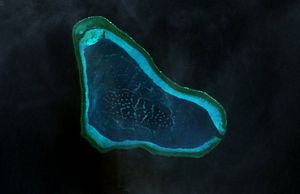Back in 2012, Scarborough Shoal was at the center of a major stand-off between China and the Philippines that presaged the current period of instability in the South China Sea. Though Beijing’s assertiveness, as demonstrated through its artificial island-building and construction activities, is today largely focused primarily in the Spratly Islands, the 2012 stand-off presaged much of what was to come in the South China Sea. In 2016, Scarborough Shoal could soon to be returning to headlines.
Located in waters disputed between China, Taiwan, and the Philippines, west of the Philippines’ Luzon island, Scarborough Shoal is now being cited by U.S. government officials as a possible next site for increased Chinese activity in the South China Sea. Speaking to Reuters, Admiral John Richardson, the U.S. Navy’s chief of naval operations, noted that there is increased Chinese “surface ship activity” near Scarborough Shoal. He adds that there is additionally some “survey type of activity” in the area, noting that it was “an area of concern … a next possible area of reclamation.”
Richardson said he didn’t know if Chinese activity at the shoal had anything to do with the pending decision at the Permanent Court of Arbitration in the Hague in Philippines v. China, a case filed by Manila that has asked the international court to rule on China’s excessive maritime claims in the South China Sea. Most observers expect a ruling that will be almost entirely favorable to the Philippines’ position on the status of features currently occupied by China in the Spratlys. Expected in late-May or early-June 2016, the decision will be an important moment for China, which could find itself in contravention of an international court ruling given many of its activities in the South China Sea.
Scarborough Shoal itself is one of the features under consideration in the pending case at the Permanent Court of Arbitration. The Philippines argues that the feature falls within its 200 nautical mile exclusive economic zone, as stipulated under the United Nations Convention on the Law of Sea, the primary international treaty on maritime law that both Beijing and Manila have signed and ratified. Beijing, meanwhile, has said it will ignore the court’s ruling in this case and broadly claims Scarborough Shoal within its ambiguous nine-dashed line claim in the South China Sea. The Asia Maritime Transparency Initiative at the Center for Strategic and International Studies has a good run-down of the various ways in which the court could rule on Scarborough and how they would affect legal outcomes.
China has controlled Scarborough Shoal since 2012, after a months-long stand-off with the Philippines. If Richardson’s fears prove true, Beijing would be significantly expanding its assertive behavior in the region. Though its Spratly artificial islands have caused controversy, the features it improved through dredging and expansion were previously occupied by China. Given Scarborough’s troubled history as a feature that was effectively won over from the Philippines just four years ago, any significant land reclamation work there would be considerably more worrisome for Manila and, certainly, for the United States.

































